The Search for Lonely Doug
PeriBlog II: Port Renfrew, British Columbia, Canada.
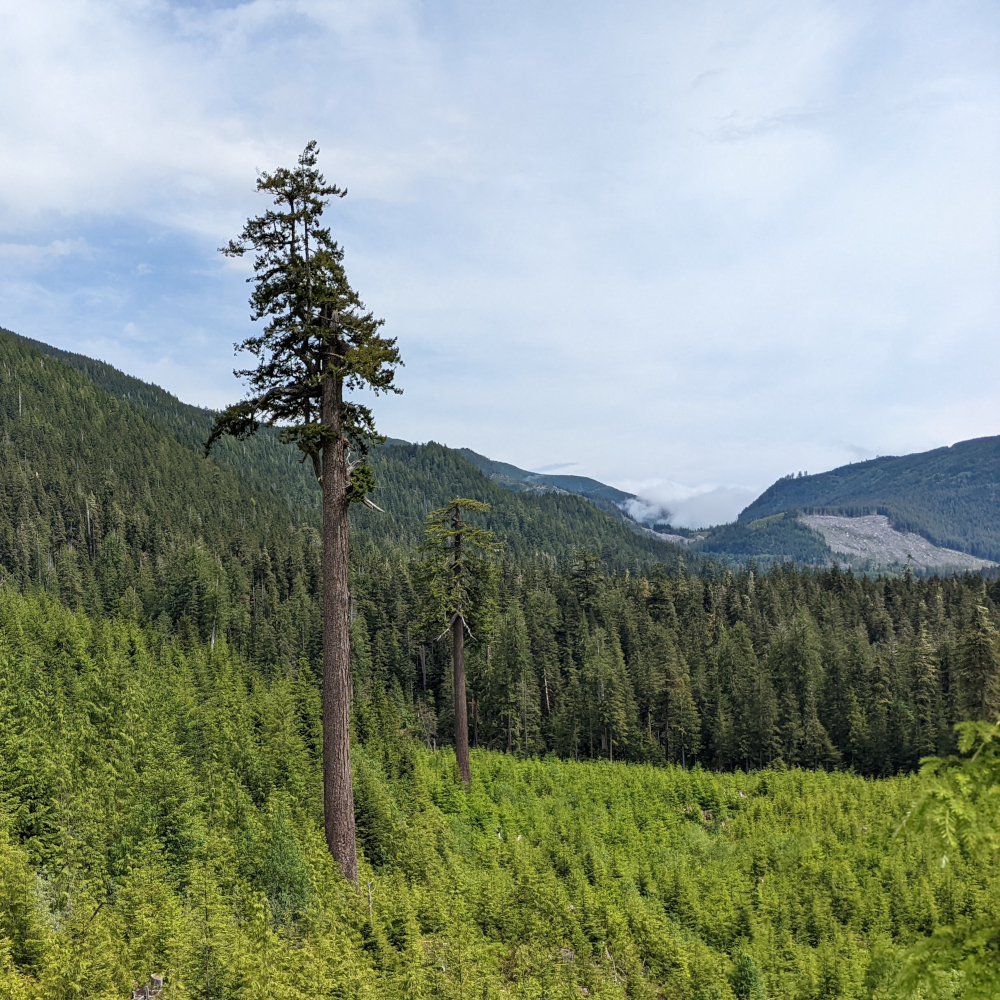
Lonely Doug, standing alone in his field
If you want to get away from it all, Port Renfrew, British Columbia, Canada, is a viable destination. Located on the southwestern edge of the island, it is one of the few places where one can actually access the island’s West Coast by automobile. Thirty-three miles, as the Bald Eagle flies, separate Sooke and Port Renfrew. Those lacking the advantage of wings face an eighty minute drive over a two lane “highway” that undulates in three dimensions—pitch, yaw, and roll. The land route adds eleven miles to the distance. The narrow asphalt traces a line across the forest-shrouded headlands overlooking the Strait of Juan de Fuca, crosses creek-sliced ravines over single lane bridges, and ultimately reaches its destination, the thriving metropolis of Port Renfrew.
Port Renfrew is a one-horse town, after the horse ran away.
Officially designated an “unincorporated community,” it offers a tiny general store, a couple of rustic hotels, a collection of cafes, and two marinas. The gas station, a sign notes, reopened in 2021—what the 144 permanent residents did for petrol before that happy event is unclear.
Named “The Tall Tree Capital of Canada,” the region receives an astonishing 137 inches of rain each year. The Pacific precipitation keeps the region green, and I expect that the fire danger rarely strays from “low.”
Difficult to reach, lacking in many tourist amenities, a congenial climate—Port Renfrew is my kind of place.
Botanical Beach
Port Renfrew’s stellar attraction is Botanical Beach, located about three kilometers southwest of the town “center.” Here, where sea strikes land, is one of Canada’s best collections of tide pools.
Walking down the hill toward the shore, the trail runs through a deep glen of spruce and cedar trees. An educational signboard advises that, among the critters we might see—bears, cougars, the yellow-spotted millipede—a sharp-eyed hiker might also sight the “Dromedary Jumping slug.”
Dromedary Jumping slug?
Adrenaline surges, right out to my fingertips. I have spent sixty years on this planet without seeing this amazing gastropod. And now my opportunity has arrived.
According to my research, the Dromedary Jumping slug is one of seven species of jumping slugs that inhabit the Pacific Northwest. Experts claim that these land-based mollusks don’t actually jump—they writhe, flailing about like a beached tuna. For those who are having trouble visualizing this beast in action, here is a link to some rare YouTube footage: LINK
Flushed with anticipation, I continued down the trail, scanning the forest floor for jumping slugs. Unfortunately, my quest came up empty, although I did find a nice yellow-spotted millipede.
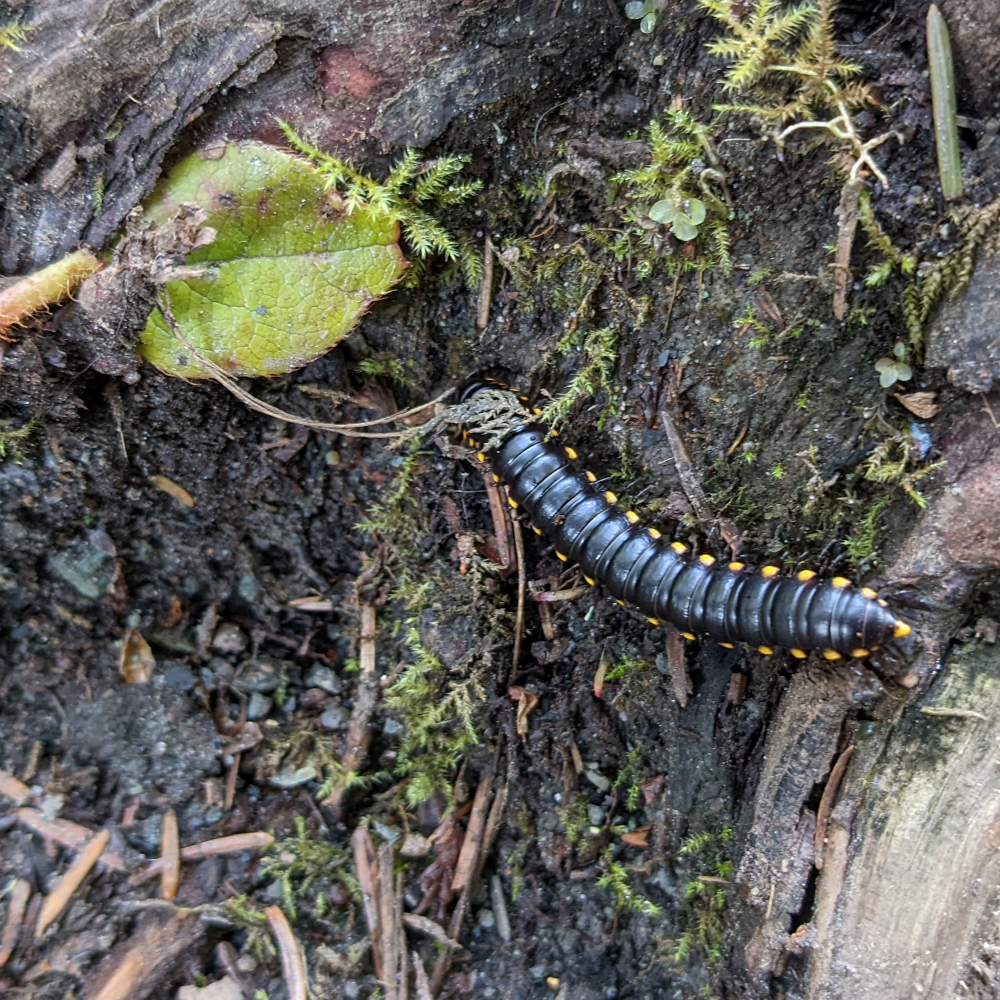
A yellow-spotted millipede in action
Botanical Beach is a geological oddity. Layers of gray shale angle skyward, veined with inclusions of white quartz. A large sandstone shelf runs for about a quarter mile. Tide-etched and storm-pounded, the sandstone is riddled with pools that retain seawater when the water recedes.

Sandstone bench and tide pools.
New pools are created when storms toss boulders ashore, smashing the smooth sandstone floor. Further erosion, amazingly, is produced by purple sea urchins, which carve softball-sized nooks into the sides of the pools, where they lodge like pigeons in a dovecote.

Sea urchins nesting in the side wall of a tide pool
The tide pools offer shelter to an amazing variety of tide pools and sea life. Tiny sculpins dart along the sandy bottoms of the pools. Green sea anemones wave long tentacles. Armored chitons, looking like scaled-down models of a prehistoric ankylosaurus cling to the rocks as hermit crabs lug their snail shell accommodations around the sea grass and kelp.

A pair of chitons, a legacy of our prehistoric past
As I study a tide pool, a mink swims up a channel into the sandstone, slips between two large boulders, and then dashes for the green forest above the high tide mark.
It is that sort of place.

Purple sea urchin
With the tide rising and the sun at apogee, it was time for lunch. We hiked the rest of the Botanical Beach trail, returned to our car, and then drove east to the Port Renfrew Pub. Here we enjoyed a lovely lunch (although, rather mysteriously, I have yet to find an oyster burger on Vancouver Island). The pub and hotel sit at waterside, overlooking a small marina and Port San Juan, the harbor.
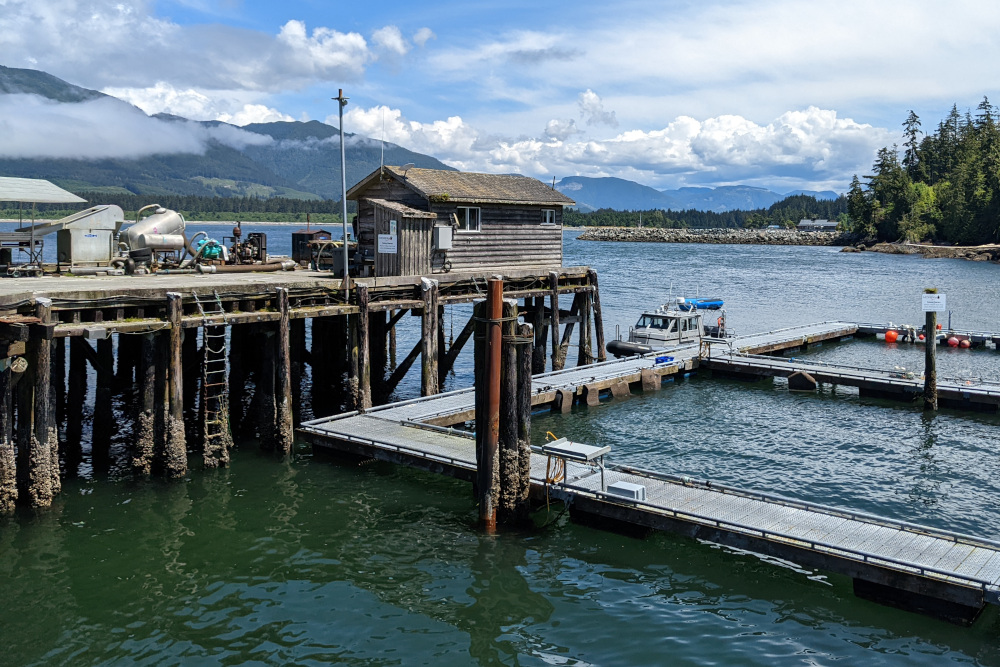
Marina, Port San Juan
Refueled for the arduous journey ahead, we continued to drive east. I turned off into a small residential area. A group of houses lined a short, dead end street, the picturesque Tsonoqua Drive. I piloted our car around a dog, sleeping in the middle of the road. A little further, two women sat on the sidewalk in lawn chairs. Nearly every house boasted a sign enjoining drivers to “slow down.”
Really?
If things slowed down much more in Port Renfrew, they would begin running in reverse.
These signs mystified me. “Do you really want your fender dented by my dog or child?” asked one. It was impossible to believe, on this short quarter mile, dead end street that speeding would be a major problem. I would be surprised if more than a car an hour graces that particular sheet of asphalt. Was there truly a speeding problem in this Port Renfrew suburb?
Perhaps boy racers drive out from Sooke on Friday nights and turn Port Renfrew into Le Mans.
I don’t know, I don’t understand it, I didn’t stop to ask questions.
We had no time. Leaving picturesque Port Renfrew behind us, we proceeded north in search of giant trees.
Lonely Doug
We didn’t find any, to paraphrase Arlo Guthrie, until we came to a side road. And off to the side of the side road, was a cliff, the famous “Avatar Grove” (Upper and Lower).
To reach the “Upper” Grove, one must climb a hill, hiking shoes slipping on dew-soaked slicken-stone, and toes often trapped in tangle-root. But oh the reward. At the top of a lung-puffing ascent is a tree with a large burl at its base.
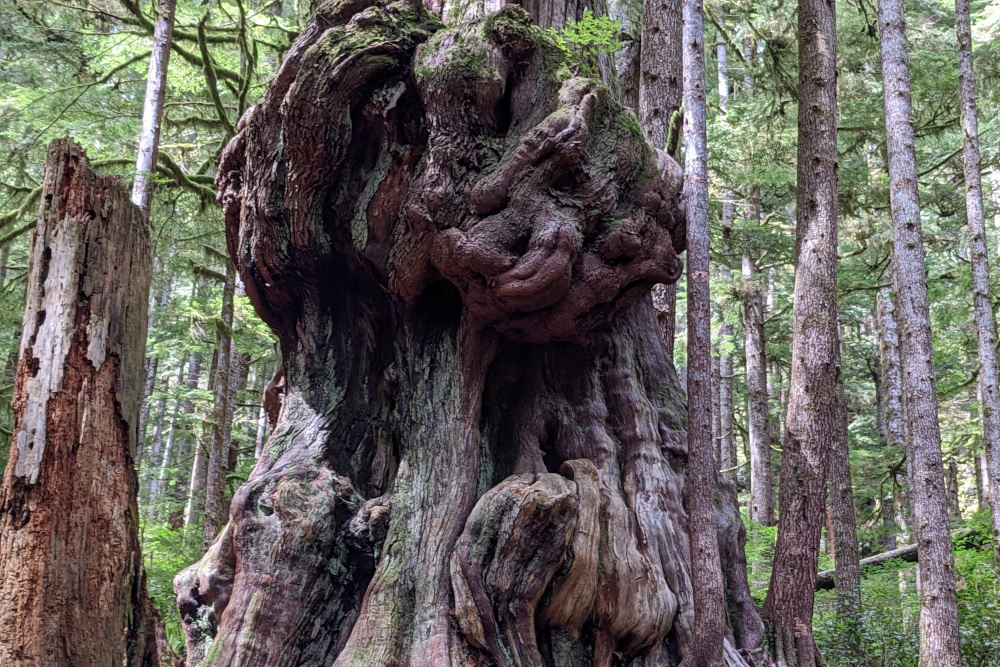
Enormous burl
A burl, for those of you who are not up on tree lore, is an enormous growth caused by a disruption to a tree’s cambial layer. It is not clear what causes these abnormal swellings, but it doesn’t seem to be contagious. There’s some good news for all of you hikers.
The Lower Grove contains some fine specimens of old growth trees, but I have to admit that I was distracted. I hadn’t thought we were going to stop here, and I viewed it as a distraction from the day’s highlight, the quest for Lonely Doug.
Lonely Doug is perhaps the most famous tree in the world—second only, perhaps, to Seth the Sequoia. Several years ago, when loggers passed through this part of the island, a kind surveyor instructed the chainsaw wielders to steer clear of one old growth Douglas fir tree.
They obeyed this instruction, but hacked down all of the other trees, leaving Lonely Doug standing by himself on a stripped hillside. Now he is lonely
Had I known in advance the difficulties that awaited, I would have left him to his solitude. We drove up a deeply rutted gravel logging, shaking out the fillings in our teeth as our valiant Subaru plunged into one massive pothole after another. Finally, we reached a bridge. Our guidebook warned that unless we were in a four-wheel drive vehicle with high clearance, we should finish the rest of the journey on foot.
How bad could it be? I wondered.
I eased the Subaru into drive and started up a hill. Our front end see-sawed into a hole.
I parked the car by the side of the road.
We continued on foot.
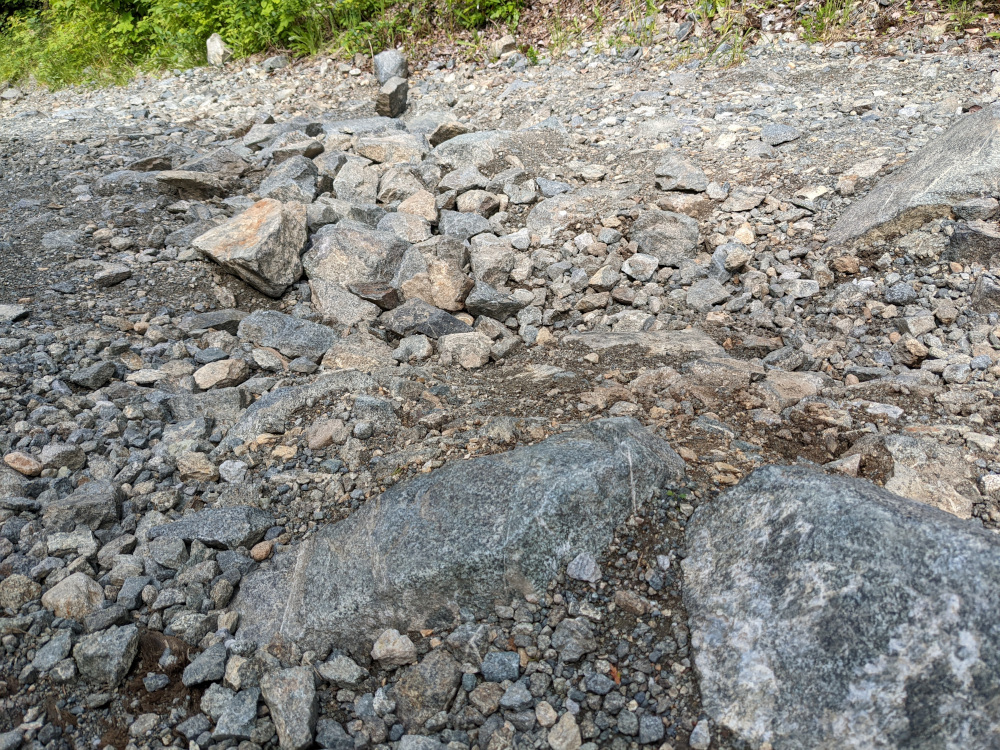
A classic case of a road that is worse than it looks
Well, eventually we found Lonely Doug, standing in his field. There really isn’t much to write about it. He’s a tree. We came and saw him. We had a long pothole road back to Port Renfrew.
My car’s suspension may never be the same.
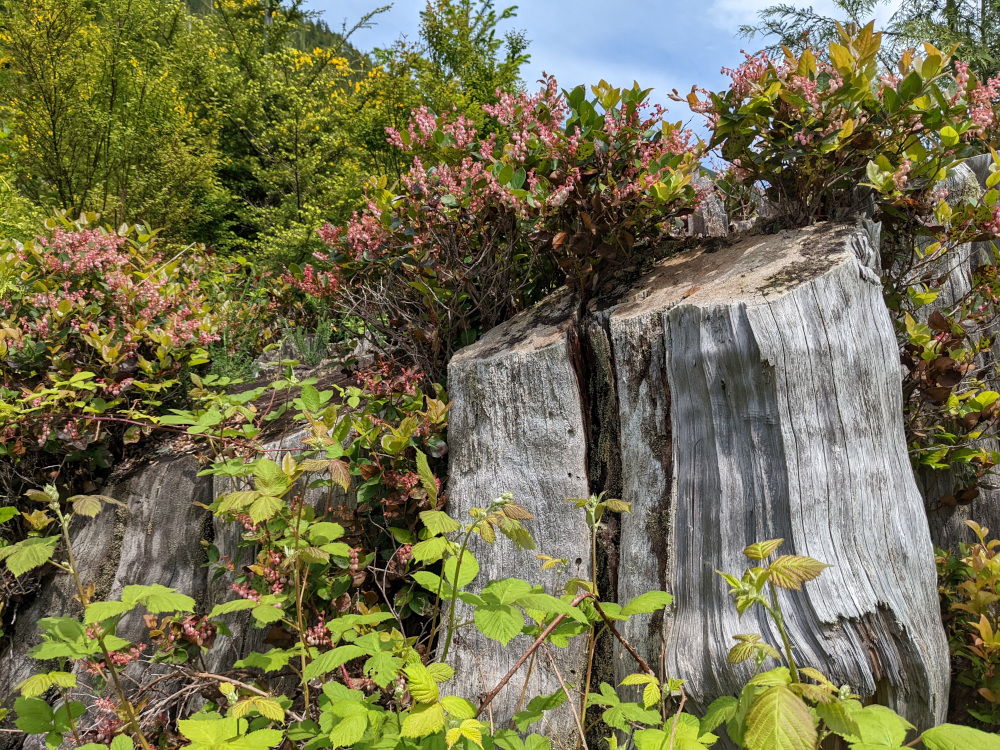
One of Lonely Doug’s friends (deceased).
If you are enjoying this series, why not subscribe to Richard's monthly newsletter, What's New in Old News? The Peripatetic Historian is on the road, roaming the world and compiling fresh adventures. Don't miss out. Click here to join the legions of above-average readers who have already subscribed.